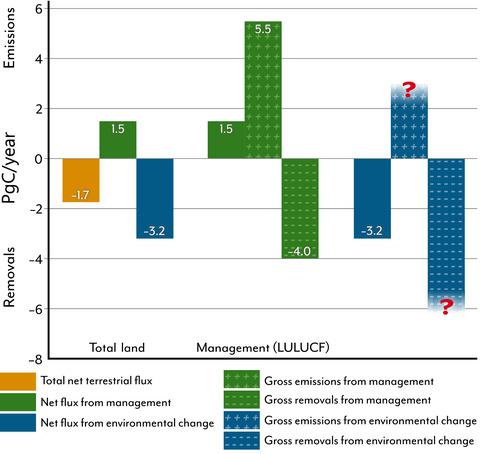当前位置:
X-MOL 学术
›
Glob. Change Biol.
›
论文详情
Our official English website, www.x-mol.net, welcomes your
feedback! (Note: you will need to create a separate account there.)
Terrestrial fluxes of carbon in GCP carbon budgets.
Global Change Biology ( IF 10.8 ) Pub Date : 2020-03-24 , DOI: 10.1111/gcb.15050 Richard A Houghton 1
Global Change Biology ( IF 10.8 ) Pub Date : 2020-03-24 , DOI: 10.1111/gcb.15050 Richard A Houghton 1
Affiliation

|
The Global Carbon Project (GCP) has published global carbon budgets annually since 2007 (Raupach et al., 2007; Canadell et al., 2007). There are many scientists involved, but the terrestrial fluxes that appear in the budgets are not well understood by ecologists and biogeochemists outside of that community. The purpose of this paper is to make the terrestrial fluxes of carbon in those budgets more accessible to a broader community. The GCP budget is composed of annual perturbations from pre-industrial conditions, driven by additions of carbon to the system from combustion of fossil fuels and by transfers of carbon from land to the atmosphere as a result of land use. The budget includes a term for each of the major fluxes of carbon (fossil fuels, oceans, land) as well as the rate of carbon accumulation in the atmosphere. Land is represented by two terms: one resulting from direct anthropogenic effects (Land Use, Land-Use Change, and Forestry (LULUCF) or land management) and one resulting from indirect anthropogenic (e.g., CO2 , climate change) and natural effects. Each of these two net terrestrial fluxes of carbon, in turn, is composed of opposing gross emissions and removals (e.g., deforestation and forest regrowth). Although the GCP budgets have focused on the two net terrestrial fluxes, they have paid little attention to the gross components, which are important for a number of reasons, including understanding the potential for land management to remove CO2 from the atmosphere and understanding the processes responsible for the sink for carbon on land. In contrast to the net fluxes of carbon, which are constrained by the global carbon budget, the gross fluxes are largely unconstrained, suggesting that there is more uncertainty than commonly believed about how terrestrial carbon emissions will respond to future fossil fuel emissions and a changing climate.
中文翻译:

GCP碳预算中的陆地碳通量。
自2007年以来,全球碳计划(GCP)每年都会发布全球碳预算(Raupach等,2007; Canadell等,2007)。有很多科学家参与其中,但是该社区之外的生态学家和生物地球化学家对预算中出现的地面通量还没有很好的理解。本文的目的是使更广泛的社区更容易获得这些预算中的陆地碳通量。GCP预算由前工业化条件引起的年度扰动组成,这是由化石燃料燃烧向系统中添加碳,以及由于土地利用而将碳从土地向大气的迁移驱动的。该预算包括每个主要碳通量(化石燃料,海洋,陆地)的术语以及大气中碳的积累速率。土地用两个术语表示:一个是由直接的人为效应(土地利用,土地利用变化和林业(LULUCF)或土地管理)产生的,另一个是由间接的人为因素(例如二氧化碳,气候变化)和自然效应产生的。这两个陆地净碳通量中的每一个又由相对的总排放量和清除量(例如,森林砍伐和森林再生)组成。尽管GCP的预算集中在两个净地面通量上,但它们却很少关注总构成,总构成因许多原因而很重要,其中包括了解土地管理从大气中清除二氧化碳的潜力以及了解负责任的流程为陆地上的碳汇。与受全球碳预算约束的碳净通量相比,
更新日期:2020-04-22
中文翻译:

GCP碳预算中的陆地碳通量。
自2007年以来,全球碳计划(GCP)每年都会发布全球碳预算(Raupach等,2007; Canadell等,2007)。有很多科学家参与其中,但是该社区之外的生态学家和生物地球化学家对预算中出现的地面通量还没有很好的理解。本文的目的是使更广泛的社区更容易获得这些预算中的陆地碳通量。GCP预算由前工业化条件引起的年度扰动组成,这是由化石燃料燃烧向系统中添加碳,以及由于土地利用而将碳从土地向大气的迁移驱动的。该预算包括每个主要碳通量(化石燃料,海洋,陆地)的术语以及大气中碳的积累速率。土地用两个术语表示:一个是由直接的人为效应(土地利用,土地利用变化和林业(LULUCF)或土地管理)产生的,另一个是由间接的人为因素(例如二氧化碳,气候变化)和自然效应产生的。这两个陆地净碳通量中的每一个又由相对的总排放量和清除量(例如,森林砍伐和森林再生)组成。尽管GCP的预算集中在两个净地面通量上,但它们却很少关注总构成,总构成因许多原因而很重要,其中包括了解土地管理从大气中清除二氧化碳的潜力以及了解负责任的流程为陆地上的碳汇。与受全球碳预算约束的碳净通量相比,










































 京公网安备 11010802027423号
京公网安备 11010802027423号